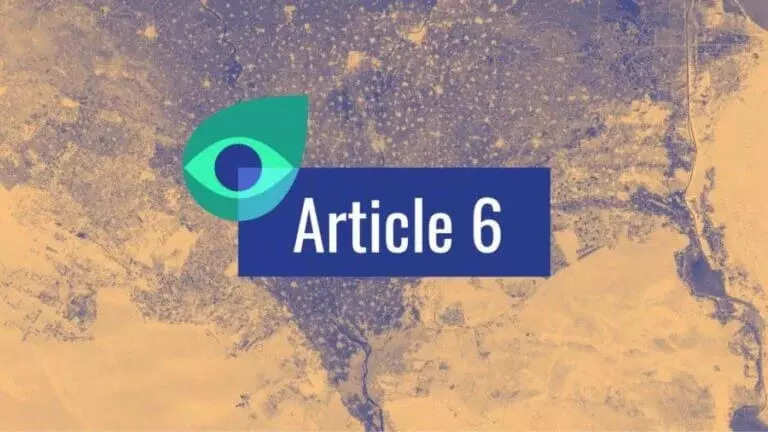[ad_1]

Why Article 6 Matters Now
In the evolving landscape of global climate action, carbon markets act as a key tool in addressing climate change. As nations prepare for COP29, the spotlight turns to strengthening this carbon market mechanism. The Earth’s surface temperature had already increased by 1.45°C by the end of 2023 and is likely to exceed 1.5°C above pre-industrial level temporarily in next 5 years. Current climate targets and policies have critically fallen short of limiting the temperature rise to 1.5°C. High quality and high-integrity carbon credits can mobilize finance, including private sector contributions, to support additional mitigation efforts worldwide while also creating avenues for sustainable development. By purchasing carbon credits, countries and non-state actors can fund activities that generate extra mitigation and support adaptation efforts across the value chain. Depending on how these carbon credits are used and accounted for, they could help address the deficit in climate action. Three key issues are discussed in this piece: the trust in the carbon market, effective use of Article 6 and starting the new carbon market.
The Matter of Trust
The majority of approaches to carbon offsets have earned a reputation for being ineffective in achieving net zero emissions globally. Carbon market stakeholders have scrutinized and raised concerns about various aspects of the environmental and social integrity of carbon credits from specific activities (mostly AFOLU related) and crediting standards. As a result, there is a general lack of trust in the environmental and social integrity of carbon credits available in the market, undermining their contribution to mitigation and sustainable development. However, there is much that is being done to build the trust in the carbon markets. Under the Paris Agreement, the A6.4 Mechanism Subsidiary Body has been tasked with developing carbon credit quality criteria and methodologies, drawing on lessons from the Clean Development Mechanism (CDM) and other crediting programs. Several governments including Australia, have commissioned independent reviews of carbon credit integrity. In parallel, the Integrity Council for the Voluntary Carbon Market (ICVCM) and the Carbon Credit Quality Initiative (CCQI) have developed criteria and frameworks for assessing carbon credit quality. The ICVCM promotes carbon credit quality by issuing labels to credits that meet its Core Carbon Principles (CCPs). The expectations are also shifting, in part because of increasing greenwashing accusations. This has created a new trend where, buyers are now vetting carbon credit suppliers, rather than relying solely on carbon market standards to ensure project credibility. Additionally, independent carbon credit rating agencies such as BeZero have also found space in this area. This shift is even more accelerated by companies facing reputational penalties for purchasing carbon credits to achieve net zero targets without sufficiently investing in the removal of GHGs from their own activities.
Accelerating Adaptation Through Carbon Finance
Another key discussion point at COP29 would be the Share of Proceeds (SOP). SOP is required for all Article 6.4 issuances but is only encouraged for Article 6.2 trades on a voluntary basis. SOP is applied as both a volume of issued units and a monetary contribution i.e. 5% of issued carbon units under Article 6.4 will be transferred to a new account within the Adaptation Fund, established in 2021. This is similar to the Kyoto Protocol, where 2% of Certified Emission Reductions (CERs) issued for a CDM project would go to the Adaptation Fund. At COP27, it was clarified that the 5% cancellation applies to all Article 6.4 units, whether authorized or not. In the recent past, the size of the Adaptation Fund affects its contribution to meeting recipient needs for adaptation financing. Due to limited financial resources stemming from the performance of the CDM, the Adaptation Fund Board limited the funds to US$10 million per country, with the progress on Article 6.4 discussions, this was recently increased to US$20 million. Since 2010, the Adaptation Fund has committed more than US$830 million for climate change adaptation and resilience projects, including over 120 localized projects. A higher SOP will channel a much needed dedicated flow for adaptation finance to developing and least developed countries.
While India has already utilized its limit but can now leverage another US$10 million through the adaptation fund. Another funding opportunity is via the Article 6.2, more specifically, India has approached A6.2 through assessing its finance needs, while countries such as Ghana and others (with conditional and unconditional NDC targets) have assessed the total volume of ITMOs they can allow without running the risk of impacting their NDC targets. However, getting the balance between the stated climate finance targets while accounting for the NDCs will also be critical for India – as India prepares to launch its own domestic compliance and offset carbon market mechanisms. India has defined what sectors to finance via A6.2, it now must define how many units at what price they could transfer internationally without undermining the achievement of its NDC.
A New Beginning and a CDM Legacy
The Clean Development Mechanism (CDM) under the Kyoto Protocol was one of the world’s first international carbon finance schemes. At COP26, it was decided that 2013 would be the cut-off for credits and projects transitioning from CDM to Article 6.4. Projects must request to transition by the end of 2023, with the process concluding by the end of 2025. Host countries will exert significant control over the transition and will need to apply corresponding adjustments on units generated by transitioned projects. Globally, over 3000 projects have applied to transition, with 998 from India. India’s position on avoiding double claiming between national targets and voluntary use of carbon credits will be critical at COP29. According to the New Climate Institute, this transition could result in a transfer of around 341 million CERs from the CDM with the 2013 registration cut-off. It is important to note that CERs used towards the 1st NDC are not considered ITMOs (Article 6.2 units). ITMOs are generated in 2021 or later, whereas eligible CERs are from 2013-2020. ITMOs are expected to be traded at higher costs compared to CERs, and the market may not rely heavily on legacy credits from the CDM.
Much at Stake
The evolving carbon market mechanisms under the Paris Agreement are crucial for achieving global climate goals. Ensuring the integrity and quality of carbon credits is imperative to build trust and drive substantial climate action. As nations prepare for COP29, building robust frameworks and clear guidelines will be essential for the effective transition of CDM credits and utilization of A6.4 carbon credits to support sustainable development.
The Indian Carbon Market, is helping the country define the institutional arrangements to authorize, aligning Article 6 strategies with broader climate targets, and establishing processes to comply with reporting requirements internally. It is also helping the Indian industries relook at their emission reduction activities as opportunities use the carbon markets as a tool for viability gap funding. India’s proactive role in leveraging Article 6 mechanisms and addressing double counting through its national carbon market will be pivotal in setting a precedent for other developing nations and maximizing the benefits of carbon finance.
[ad_2]
Source link



